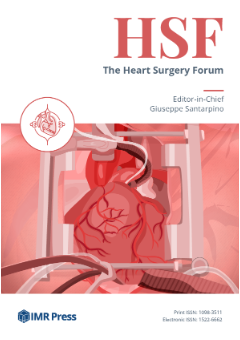Announcements
The Heart Surgery Forum (HSF) is published by IMR Press from Volume 28 Issue 9 (2025). Previous articles were published by another publisher under the CC-BY-NC licence, and they are hosted by IMR Press on imrpress.com as a courtesy and upon agreement.
Open Access
Article
Excellent Results of Contemporary Coronary Artery Bypass Grafting with Systematic Application of Modern Perioperative Strategies
Heart Surg. Forum 2007, 10(5),
349–356;
https://doi.org/10.1532/HSF98.20071067
Published:
13 September 2007
Abstract
Background.The patient population referred for coronary artery bypass grafting (CABG) has become more challenging. The surgical population is aging and patients present with significant preoperative comorbidities. This worsening risk profile has led to the development of operative techniques (off-pump CABG) and perioperative measures (epi-aortic scanning, intensive insulin therapy) to preserve the quality of care following CABG. The aim of this study was to determine the outcome of contemporary CABG following the implementation of the above measures in our practice.Methods.We retrospectively analyzed prospectively collected data of 2725 patients undergoing CABG between 01/1998 and 12/2005 (mean age, 65 ± 11 years; 843 [31%] female; mean ejection fraction, 45% ± 14%). Outcome measures included hospital mortality, postoperative complications, and long-term survival and independent predictors of outcome. Subgroup analyses were performed for 2 study periods (1998-2002 versus 2003-2005) where the above measures were implemented and for patients undergoing conventional versus off-pump CABG.Results.When comparing the 2 study periods, we observed a substantial worsening of the risk profile with an increased EuroSCORE predicted mortality from 6.4% ± 6.8% to 7.0% ± 7.8% (P= .028). During the same period, operative mortality decreased from 2.4% to 0.7% (P< .001). This reduction in mortality was also observed in diabetic patients (3.1% versus 1.0%,P= .021) and those with low ejection fraction (4% versus 2.6%,P= not significant). Off-pump procedures were performed with an increasing frequency in high-risk patients in whom we obtained excellent results. Finally, we observed a reduction of postoperative complications including respiratory failure (P= .013), gastrointestinal complications (P= .017), and stroke (P= .094). Independent predictors of mortality included renal failure (OR = 5.7), peripheral vascular disease (OR = 2.9), intra-aortic balloon pump (OR = 4.8), reoperation (OR = 3.3), and hypertension (OR = 2.3).Conclusion.Despite a worsening case mix, contemporary CABG can be performed with excellent results (operative mortality < 1%). Off-pump CABG performed in very high-risk patients obtains results similar to those of the general CABG population. Diabetes and ejection fraction were not independent predictors of early outcome. In our experience, these excellent outcomes were achieved by adopting an operative approach using modern perioperative management (epi-aortic scanning, intensive insulin therapy) and surgical techniques (off-pump CABG) based on individual patients.

